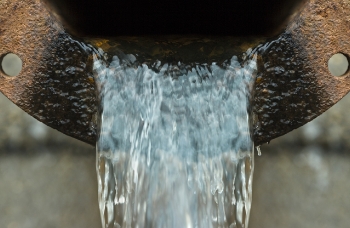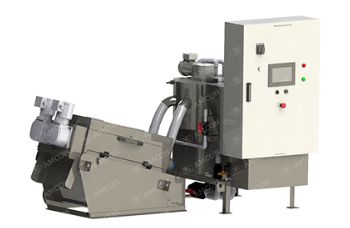What is Sludge Treatment?
In our daily lives, we flush toilets, drain water in the bathroom, wash clothes in the laundry machine, and wash dishes in the kitchen. A family of four produces about 2,000 0.5-liter PET bottles of wastewater per day. However, people’s awareness of wastewater treatment and sludge treatment issues is not high, partly because wastewater disappears in front of us once it is flushed away.
The flushed water is conveyed to a sewage treatment plant where it is purified and separated into “water” and “sludge.”
Purified “water” can be reused, but the problem is this “sludge.” Unfortunately, little is known that the “sludge” contributes to global ecological damage.
What is Sludge?

What Can Sludge Dewatering Machine Do?


Advantages of VOLUTE™ Dewatering Press

Sludge is industrial waste generated from all of wastewater treatment sites. For this reason, sludge dewatering machines are widely used not only in public sewage treatment plants but also in factories and farms that discharge wastewater above a certain volume as required by the laws of each country.
Various types of sludge dewatering presses exist, but they are mainly classified into belt press type, centrifugal separation type, filter press type, and screw press type. Our sludge dewatering machines or dewatering presses can be positioned as improved and evolved versions of the screw press type, and feature a mechanism that mechanically prevents clogging in the filtration zone, which has been a drawback of all types of systems, and facilitate direct dewatering of low-concentrated sludge. In particular, a mechanism that mechanically prevents clogging in the filtration zone has greatly improved energy efficiency and maintainability compared to those of conventional systems.
In addition, by realizing ultra-compact design, which was difficult to achieve with conventional systems, municipalities of a size that could not find an economic rationale for the introduction of sludge dewatering presses is now be able to introduce our dewatering presses.
For example, in Europe, it is standard practice for municipalities with a population of 5,000 or less to arrange for a mobile dewatering truck to dewater once a week or so. Or, conventional products with excessive throughput are unavoidably introduced and perform dewatering once a week. In these cases, however, the amount of nitrogen that is contained in the dewatered filtrate being returned to the wastewater treatment, could become so large as it is treated all at once. As a result, the balance with the microorganisms would worsen and the maintenance efficiency would deteriorate. Since these municipalities that manage sewage treatment plants with such problems are small in scale, this has not been recognized as a social problem. However, with the introduction of the VOLUTE™ ultra-small dewatering machine, users can now dewater the sludge on the spot as it is generated, instead of storing it unnecessarily, enabling stable wastewater treatment maintenance and cost reduction. The ultra-compact models are rare in the world, and this is one of the advantages of the VOLUTE™ Dewatering Press.